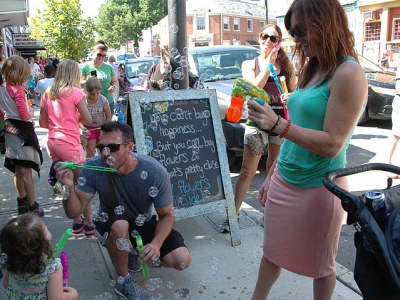State cuts have local budget impact
- Published: March 31, 2011
Local institutions are reeling from the release of Gov. John Kasich’s biennial budget last week, which proposes funding cuts for local governments, schools, libraries and elder care facilities. While the budget still must pass the state legislature, the Village of Yellow Springs, Miami Township, the Yellow Springs School District, the Greene County Public Library and Friends Care Community are already preparing to trim expenses.
Local governments hit
In the budget, which takes effect July 1, the local government fund takes a 21-percent hit in the first year, with cuts increasing to 50 percent by year two. For Yellow Springs, that amounts to a decline of about $85,000 in state aid by the second year of the budget, according to Village Manager Mark Cundiff.
Though Kasich has said that money taken from local government may be replaced with casino revenue, it will take several years to see any casino-generated income for local governments, Cundiff said.
Planning ahead, the Village didn’t include local government fund revenues in its 2011 general fund budget, which in total allocates $3.3 million in expenses. Instead, Cundiff worked to tighten individual department budgets and plan conservatively.
“I think clearly we’re going to have to be more cognizant, and look for ways to save money and be more efficient,” Cundiff said, adding that the Village is exploring how it might provision services regionally, or in partnership with Miami Township or the school district.
A bigger hit to Village coffers would come from the proposed repeal of the estate tax now making its way through the legislature. Though the annual revenue varies greatly, the Village has received an average of $250,000 per year over the last five years from the estates of deceased residents.
For Miami Township, the estate tax is a larger percentage of its total budget, projected at $1.2 million for 2011. The Township receives about $100,000 per year from the estate tax, most of which it dedicates to a green space fund used to purchase conservation easements. And the Township will also lose money from the state’s local government fund, from which the Township currently takes in about $55,000 per year.
“If the estate tax were to disappear, then so would that green space fund,” said Township Trustee Mark Crockett.
Some years the Township receives even more from the estate tax. In 2008, it took in $320,000. Much of that amount was spent on road repair or was saved to buy new equipment for the Township, such as a new fire truck, according to Township Fiscal Officer Margaret Silliman.
“If we lose [the estate tax] it would impact our general operations as well as money for green space,” Silliman said.
Schools lose some funds
The Yellow Springs School District faces significant cuts of at least 11 percent of state funding, according to Superintendent Mario Basora, who originally projected a 5 percent cut in his 2011 budget.
“This is a very significant cut and it will hurt us quite a bit,” Basora said.
Though details are still forthcoming and state leaders have publicly affirmed the state will not reduce the per pupil funding to schools, the district faces cuts from reductions to the tangible personal property tax reimbursement and the elimination of funding for specific programs, District Treasurer Dawn Weller said.
The tangible personal property tax reimbursement, which provided about $360,000 last year, would fall by 37.2 percent the first year and an additional 34.2 percent by year two, for a cumulative loss of about $342,000 over two years. Line-item funding for career technical, gifted, drug-free and violence prevention programs was also slashed, removing several thousand dollars of funding currently going to these programs locally.
In addition, the fall in revenue for the district will be compounded by the state’s decision to not continue federal stimulus funding, which in fiscal year 2010–11 year boosted the district’s budget by $184,000. The district’s total operating expenses last year were about $6.9 million.
“It’s unfortunate we’re getting more cuts, but I’m optimistic we’ll get through this and that the community will help keep our schools intact,” Basora said. “We’re looking at anything we can do to cut costs without raising class sizes. We’re doing whatever we can do without jeopardizing the education of our kids,” he said.
Last week the school board approved $437,000 in cuts to its 2011–12 budget, including 5.1 full-time equivalent positions.
Changes to the amount the district contributes to the state retirement systems are projected to save the district about $97,200 per year, however. In addition, Basora expects that financial incentives will be offered to districts that comply with likely changes to collective bargaining or incorporate performance-based pay, for example.
Library faces smaller cut
The state budget shaves 5 percent off of library funding from its fiscal year 2011 level, a cut that was far less than libraries feared, but still significant in a historical context, said Karl Colón, director of the Greene County Public Library.
“These cuts do actually show that the legislature is paying attention to the record level of library use and the value that communities place on the library,” Colón said. Cuts of up to 15 percent were anticipated.
The budget proposal freezes library funding at 5 percent below its 2011 level, rather than an adjustable amount dependent upon the economy. But the 2011 funding level is up just 7 percent from its dismal 2010 amount, when Greene County Library saw its state aid fall by 23 percent. That drop led the library to stay open 10 fewer hours per week and reduce staffing by 20 part- and full-time positions.
“Being frozen at the fiscal year 2011 level is certainly better than being frozen at 2010,” Colón explained, adding that though it appears to be a small cut, this year’s funding from the state was the same as it was in 1996. The Greene County Public Library relies on the state for half of its budget of about $7.6 million. The rest comes from a 1.0-mill levy passed in 2005.
Though Colón doesn’t anticipate making further reductions to hours or staff, or purchasing fewer materials for the shelves, the library will continue to work with its vendors and suppliers to cut costs, he said.
“Ultimately what we’re trying to do is to get the library to a sustainable level, to deliver the maximum services for the amount of money given to us,” Colón said.
Medicaid funding uncertain
At Friends Care Community, a local nonprofit that provides skilled care, assisted living and independent living for elders, cuts to Medicaid reimbursements could lead to reductions in staff at the facility, which employs about 100 people, according to Director Karl Zalar.
“Roughly 65 to 70 percent of our cost is people because it’s a labor-intensive business,” Zalar said. “But we’re looking far and wide for opportunities to cut expenses or increase revenue before we look at cutting staff.”
While the impact on Friends Care is still unclear, Zalar said reductions of about 7.5 percent to Medicaid reimbursements are likely. Friends Care already takes a loss on its residents who rely on Medicaid, who are about 54 percent of the facility’s population. The reimbursement of $178.80 per resident per day falls short of Friends Care’s daily per resident costs of $210.
“Already there’s a huge gap between what our costs are and what our reimbursement is,” Zalar said, explaining that the loss is offset by those residents who pay privately or utilize Medicare.
Seeing the declining trend in Medicaid reimbursements, Friends Care decided last year to build a new 16-room, $2.25 million rehabilitation wing at its Herman Street campus, in part to access more Medicare reimbursements, which are averaging $411 per day. The wing will be completed in July.
In addition, there may be additional funding from the state for elder-care facilities based upon quality of care, Zalar said. Friends Care now has a five-star rating from the Center for Medicare and Medicaid Services, a rating only 5 percent of such facilities in the U.S. achieve, Zalar said.
Still, state funding continues to move in the direction of at-home rather than institutional care.
“We will definitely have to do more with less,” Zalar said.
The Yellow Springs News encourages respectful discussion of this article.
You must login to post a comment.
Don't have a login? Register for a free YSNews.com account.

Parkinsons.jpg)













No comments yet for this article.